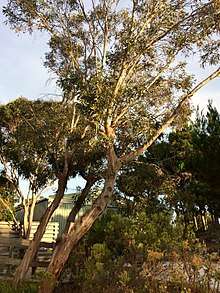Eucalyptus diversifolia
| Soap mallee | |
|---|---|
 | |
| Coastal white mallee, Kangaroo Island SA | |
| Scientific classification | |
| Kingdom: | Plantae |
| Clade: | Angiosperms |
| Clade: | Eudicots |
| Clade: | Rosids |
| Order: | Myrtales |
| Family: | Myrtaceae |
| Genus: | Eucalyptus |
| Species: | E. diversifolia |
| Binomial name | |
| Eucalyptus diversifolia | |
Eucalyptus diversifolia, commonly known as the soap mallee, South Australian coastal mallee[1] or the coastal white mallee,[2] is a eucalypt that is native to an area along the southern coast of Australia.[3]
Description
The mallee typically grows to a height of 0.5 to 8 metres (2 to 26 ft) and has smooth bark. The tree blooms between July and September or December to January and produces white to cream-yellow flowers.[3] The concolorous, glossy, olive-green or bluish-green adult leaves have an alternate arrangement. The leaf blade has a lanceolate shape and is held somewhat erect. The blades are 7 to 13 centimetres (3 to 5 in) in length with a width of 1.2 to 2.5 cm (0.47 to 0.98 in). The axillary inflorescences are unbranched on peduncles to 1.2 cm (0.47 in) long and contain seven to eleven flowers. The buds are shortly pedicellate with a diamond shape with a length of about 1.2 cm (0.47 in) and a diameter of around 0.6 cm (0.24 in). Fruits that are sessile or shortly pedicellate form later. The fruits have a cupular to obconical shape with length of 1.2 cm (0.47 in) and a diameter of 1.5 cm (0.59 in) with a level to ascending disc and four rim-level valves. The fruits contain brown, smooth and glossy seeds with a pyramidal shape.[4]
Taxonomy
The species was first formally described by the botanist Aimé Bonpland in 1814 as part of the work Description des Plantes Rares cultivees a Malmaison et a Navarre.[5]
There are three recognised subspecies:
Distribution
The range of the mallee extends from the coastal area of the Goldfields-Esperance region in Western Australia through the south coast of South Australia and as far east as the south west of Victoria.[8] It is one of the most widespread mallee species in Australia.[9]
The tree is suitable to produce large amounts of biomass, able to make 10 to 20 metric tons (11 to 22 short tons) per hectare per year. In wheatbelt regions it is also beneficial as the tree will reduce salinity, give shade to stock, act as a windbreak and reduce erosion.[9]
Gallery
- Features of Eucalyptus diversifolia
 Adult leaves
Adult leaves- Buds and leaves
 Fruit
Fruit Trunk bark
Trunk bark
See also
References
- ↑ "Eucalyptus diversifolia SA coastal mallee". ERA Nurseries. Retrieved 5 November 2016.
- ↑ "Eucalyptus diversifolia ssp. diversifolia Coastal White Mallee". Plant Selector. Retrieved 5 November 2016.
- 1 2 "Eucalyptus diversifolia". FloraBase. Western Australian Government Department of Parks and Wildlife.
- 1 2 "Eucalyptus diversifolia Bonpl. Soap Mallee". VicFlora. Royal Botanic Gardens Victoria. Retrieved 2 December 2017.
- ↑ "Eucalyptus diversifolia Bonpl. (misapplied to Eucalyptus diversifolia subsp. hesperia)". Atlas of living Australia. Global Biodiversity Information Facility. Retrieved 7 September 2017.
- ↑ "Eucalyptus diversifolia ssp. diversifolia (Myrtaceae) Coastal White Mallee". Seeds of South Australia. Government of South Australia. Retrieved 7 September 2017.
- ↑ "Eucalyptus diversifolia subsp. hesperia". FloraBase. Western Australian Government Department of Parks and Wildlife.
- ↑ "Eucalyptus diversifolia Bonpl., Pl. Jard. Malm. 35 (1814)". eucalink. Royal Botanic Garden, Sydney. Retrieved 5 November 2016.
- 1 2 "Mallee". Biomass Producer. Australian Government. 2013. Retrieved 6 May 2017.